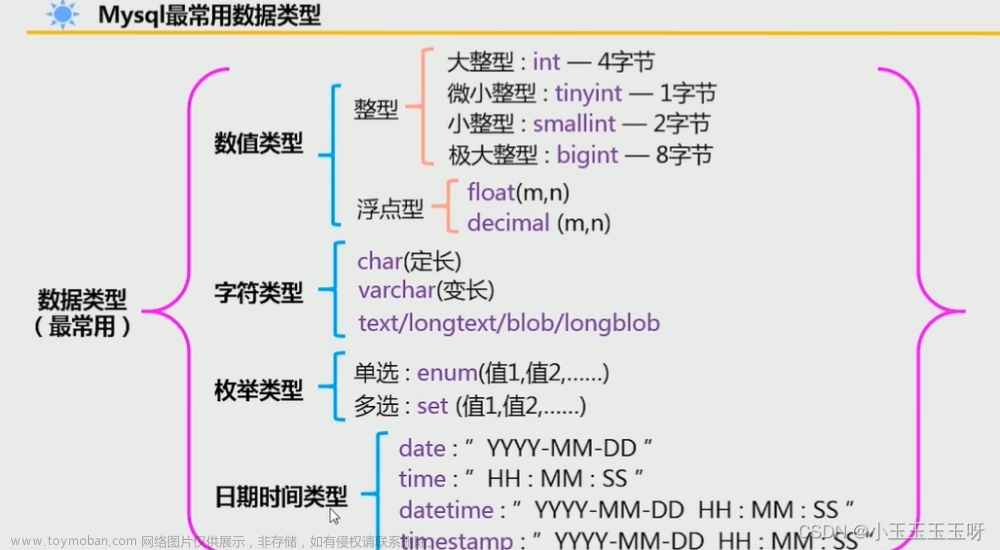整体介绍
SQL语言是一种数据库语言

1、DDL:数据定义语言
create-创建 drop-删除 alter-修改 rename-重命名 truncate-截断
2、DML:数据操作语句
insert-插入 delete-删除 update-更新 select-查询
3、DCL:数据控制语句
grant-授权 revoke-回收权力 commit-提交事务 rollback-回滚事务
注:Oracle命令不区分大小写,但数据和内容区分
一、select语法
1、基本结构和简单查询
基本结构:select 查询的信息 from 数据来源
select * from empselect deptno,sal,ename from emp*:表示查询该表的所有数据
查询的信息可以是*也可以是一个或多个字段名;多个字段之间用逗号分隔,字段的顺序即查询结果顺序
2、去重(distinct)
select distinct deptno from emp;distinct去重是去除的整条记录的重复
3、别名
给列取别名有两种写法:
写法1: 字段名后跟空格和别名
select ename 姓名,sal 工资 form emp写法2:使用as关键字
select ename as 姓名,sal as 工资 from emp;4、排序(order by)
降序:desc 升序:asc(默认升序排序)
select ename,sal from emp order by sal desc多字段排序:用逗号分隔
select ename,sal from emp order by deptno asc,sal desc解释:查询emp表中的ename,sal字段,查询结果集按照先deptno字段值升序排序,在deptno升序的基础上,按照sal降序排序;
5、伪列
生成表中没有的数据列称为伪列
select ename,sal,sal*2 年薪 from emp其中年薪属于别名而sal*2是表中没有的数据,是通过计算得到,所以称为伪列
6、字符串拼接 ||
select ename,ename || ‘a’ 别名 from emp注:两个变量拼接时,如a||b,当a为null则结果为b
7、虚表 dual
只有一行一列,是用来构成select的语法规则,可以执行插入、更新、删除操作,还可以执行drop操作
注:虽然可以执行drop操作,但是还是不建议对dual执行drop操作,否则会使系统不能用、起不了数据库。
select 11*22 from dual8、select 执行顺序
select distinct 查询字段1 别名,查询字段2 as 别名,表达式 别名 from 数据来源 order by 排序字段 desc
以上是之前知识的综合语句:
解析顺序:from====》select====》order by
先找表,再找需要查询的内容,最后对结果集排序
9、条件查询*
结构:select 查询内容 from 数据来源 where 行记录条件
解析过程:1、查询数据源 2、判断是否符合行记录条件 3、将满足条件的记录在select指定的信息中存放(结果集当中)
条件运算
=、>、<、>=、<>、!=、between and、in
基础结构:
select * form emp where deptno=10;between...and... 值在一定范围内、闭区间(包含两段界限)
select * from emp where sal between 2000 and 4000in(a,b)满足a或b都可以
select * from emp where deptno in(10,20)条件连接运算
and、or、not
and 同时满足
select * from emp where sal>1500 and deptno=20;or 满足一个即可
select * from emp where sal>1500 or deptno=20;not 取反
select * from emp where not deptno=20;10、null处理
nvl(expl,res)
null在参加计算式,结果为null,使用nvl(expl,res)处理空值:expi-表达式、res-结果
当expi不为空时,结果为expi,为空时结果为res
select ename,sal,comm,sal+nvl(comm,0)月收入 from empnull排序
nulls first、nulls last 将空值放置在列前或后
select * from emp order by comm desc nulls firstnull查询
不为空
select * from emp where comm is not null;为空
select * from emp where comm is null;不为空
select * from emp where not comm is null;11、模糊查询 like
select * from emp where like ‘%s%’%表示任意个字符 _表示一个任意字符
当模糊查询的内容包含”%“、”_“时
select * from emp where like ‘%a%%’ escape(‘a’)escape中的a属于标识符,用于证明a后的字符不是特殊字符,只对其身后的一位字符有效
如想查询‘a%’则,...like ‘%aaa%%’ escape(‘a’)
12、where子句
select * from emp where deptno = (select deptno from dept where dname = ‘SALES’)二、函数
1、函数介绍
根据函数的返回结果,分为单行函数和多行函数。
单行函数:一条记录返回一个结果。
多行函数(组函数、聚合函数):可同时对多条记录进行操作,并返回一个结果。
2、常用的单行函数
字符函数
concat(x,y):连接字符串x和y
instr(x,str,start,n):在x中查找str,从start开始,也可以从第n次开始。初始位置从1开始。
select instr(‘HelloWorld’,‘l’,1,3)from duallength(x):返回x的长度
lower(x):x转换为小写
upper(x):x转换为大写
itrim(x,trim_str):把x左边截去trim_str字符串,没有写trim_str就截去空格
replace(x,old,new):在x中,将old替换为new,替换的是能找到的所以old
substr(x,start,length):从start开始,截取length个字符,缺length默认到结尾
日期函数
sysdate、current_date:当前日期(精确到秒)
add_months(d1,n1):在d1基础上再加n1个月后的日期
last_day(d1):放回d1所在月份的最后一天
months_between(d1,d2):从d1到d2之间的月数
next_day(d1[ ,c1]):d1日期的下周星期几(c1)
转换函数
to_char(x,c):将日期或数据x按照c格式转换
to_date(x,c):将字符串x按照c的格式转换为日期
to_number(x):将字符串x转为数字型
3、组行数
avg()平均值、sum()求和、min()最小值、max()最大值、count()统计
注:null不参与运算
group by 分组
结构:select...from...group by....
select deptno,avg(sal)from emp group by deptnohaving 过滤组信息
select deptno,avg(sal)from emp group by deptno having avg(sal)>2000执行顺序:①找到数据源from emp ②对数据源进行分组group by deptno ③对分组内容进行过滤having avg(sal)>2000 ④从分组中查询数据select deptno,avg(sal)
过滤行记录和组信息
行记录的过滤是针对每条记录的筛选,组信息的过滤是针对组的筛选,是可以同时出现的先筛选行,再过滤组
结构:⑤select...①from...②where...③group by...④having...(序号代表执行顺序)
三、分页和去重
1、分页
假分页:一次查询出数据库中的所有记录,然后在每页中显示指定的记录
缺:服务器负载大 优:与数据库只对接一次
真分页:对数据库多次查询,每次只获得本页的数据并显示
缺:频繁操作数据库 优:服务器负载小
2、rownum
是对每一个结果集中的每一条记录的编号,从1开始
查询伪列rownum
select ename,sal,deptno,rownum from emp将查询出的结果集作为临时的数据来源,此时结果集中的rownum rw为普通字段
select * from(select ename,sal,deptno,rownum rw from emp)where rw>5 and rw <=103、排序分页(每页只展示3条数据)
select ename,sal,deptno,r1,r2
from(select ename,sal,deptno,r1,rownum r2
from(select ename,sal,deptno,rownum r1
from emp order by sal desc))
where r2>(3-1)*3 and r2<=3*34、rowid去重
rowid相当于伪列,由Oracle生成,是唯一的
delete from copy where rowid not in(select min(rowid)from copy group by deptno)四、表连接
概念:多表查询-多表拼接
1、92语法
结构:select...from table1,table2...where
很多时候需要为表取别名(①简化表名②可能存在自连接的情况)
原理:from后面出现的顺序,前面的表作为内存的for循环,后出现的表作为外层的for循环
笛卡儿积
两个集合中的每一个成员,都与对方集合中的任意一个成员有关联;如果没有给筛选条件,即为笛卡儿积
等值连接
在笛卡儿积的基础上取条件列相同的值
select * from emp e,deptno d where e.deptno=d.deptno非等值连接
!=、>、<、<>、between...and...
select ename,sal,hiredate,grade s from emp e,salgrade s where e.sal between losl and hisal自连接
特殊的等值连接(来自于同一张表)
外连接
内连接使用比较运算符根据每个表共有的列的值匹配两个表中的行
外连接可以是左向外连接、右向外连接或完整外部连接
注:没有+的是主表
select *
from detp d,(select count(*),deptno
from emp group by deptno)c
where d.deptno=c.deptno(+)2、99语法
笛卡儿积 cross join
select * from dept cross join emp自然连接 natural join
做等值连接,需要有(同名列,主外键关系)
select ename,empno,deptno,dname from emp natural join deptusing连接、等值连接 join using
select ename,empno,deptno,daname from emp join dept using(deptno)join on
等值:
select ename,empno,e.deptno,dname from emp e join dept d on e.deptno=d.deptno非等:
select ename,sal,deptno,grade from emp e join salgrade s on sal between losal and hisalouter join
left [outer] join on | using
right [outer] join on | using
全连接 full join on
select ... from table full join table2 on 连接条件 where...
3、集合操作
union 并集 union All 全集 instersect 交集 Minus 差集
五、DDL语法
1、表操作
创建表
create table 表名(字段名 类型(长度),...)
数据类型
详细解释可以查看官方文档
修改表结构
修改表名:
rname 原表名 to 新表名
修改列名:
alter table 表名 rename column 列名 to
修改字段类型:
alter table 表名 modify(字段类型)
alter table tb_student modify(studentId char(10))添加列:
alter table 表名 add 字段 类型
删除列:
alter table 表名 drop column 字段
2、删除表
drop table 表名
3、约束
主键约束(primary key):该字段在表中唯一且非空
唯一性约束(unique):只能出现一次
非空约束(not null):不能为空
外键约束(foreign key):外键(从表)中的数据必须在主表中已经存在才能使用
检查约束(check)
创建表的同时,将约束进行创建,约束不设定名称
create table tb_user(
userid number(5) primary key,
username varchar2(30) check(length(username) berween 4 and 20) not null,
age number(3) default(18) check(age>=18),
gender char(3) default('男') check(gender in('男','女')),
regtime date default(sysdate)
)创建表的同时,给约束设定名称
create table tb_user(
userid number(5),
username varchar2(30) not null,
age number(3) default(18),
gender char(3) default('男'),
regtime date default(sysdate),
constraint pk_user_id primary key(userid),
constraint ck_user_name check(length(username) berween 4 and 20),
constraint ck_user_age check(age>=18),
constraint ck_user_gender check(gender in('男','女'))
)创建完表后,追加约束
alter table tb_user add constraint pk_user_id primary key(userid)修改约束
alter table tb_user modify(username constrant nn_user_name no null)外键处理方式
强制不让删除
alter table tb_txt add constraint fk_txt_user_id foreign key(userid) references tb_user(userid)删除后自动设置为null
alter table tb_txt add constraint fk_txt_user_id foreign key(userid) references tb_user(userid) on delete set null级联删除
alter table tb_txt add constraint fk_txt_user_id foreign key(userid) references tb_user(userid) on delete cascade禁用和启用约束
启用/禁用(enable/disable):对后来的数据进行校验
验证/非验证(validate/novalidate):对已存在的数据进行校验
删除约束
alter table tb_user drop cpnstraint ag_user_email cascade六、DML
1、插入
insert into 表名 [(字段列表)] values(值列表)
插入记录时要满足长度兼容、约束
默认添加:
insert into 表名 values(值列表)
使用默认添加时,数据必须和表结构字段顺序和个数一致
添加时指定列和顺序
insert into 表名(指定列)values(值列表)
如果是外键,被参考的主表字段一定要有数据
2、更新
update 表名 set 字段1=值1[字段2=值2,...] where 过滤行记录
注:在更新时一定记得加上where条件
3、删除
delete from 表名 where 过滤行记录文章来源:https://www.toymoban.com/news/detail-651289.html
注:先删从表后删主表文章来源地址https://www.toymoban.com/news/detail-651289.html
到了这里,关于Oracle常用基础知识的文章就介绍完了。如果您还想了解更多内容,请在右上角搜索TOY模板网以前的文章或继续浏览下面的相关文章,希望大家以后多多支持TOY模板网!











